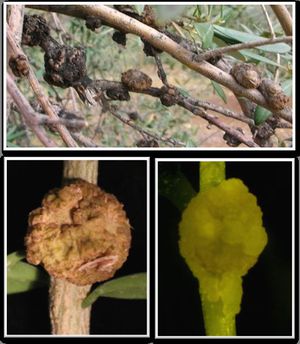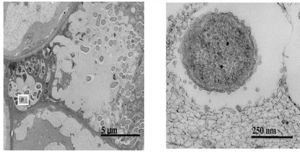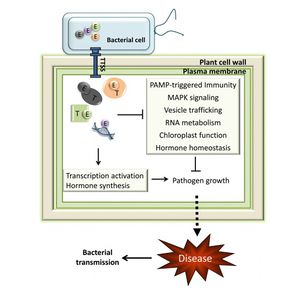Virulence of Pseudomonas savastanoi: Difference between revisions
| Line 7: | Line 7: | ||
<br> | <br>Hildy Joseph, Kenyon 2013<br> | ||
<br>< | Olive knot disease, which is characterized by knots and galls on emerging stems, branches, and occasionally leaves, was first described in the fourth century B.C. by the Greek philosopher Teophrastus. <br><i>Pseudomonas savastanoi</i> is the bacteria responsible for olive knot disease (Iacobellis 2001). Infection occurs through wounds induced by pruning or severe weather occurrences, including freezing and hail (Young 2004). Plants experience death and decay, including reduced limb size and plant size as well as defoliation, within eight months of infection (Iacobellis 2001). The overall vigor of olive trees inoculated with <br><i>P. savastanoi</i>has been shown to decline (Quesada et al. 2009). Knots tend to form in the spring during the most active growth period (Young 2004). Plant vulnerability is also increased in the autumn, in part because of other pathogens like the fungus Spilocaea oleaginea target olive trees at the same time. Thus, the chance of co-infection by <br><i>P. savastanoi</i>is heightened (Teviotdale and Krueger 2004). The bacterium spreads easily within an orchard via wind or pruning tools (Young 2004). Moreover, once infected, <br><i>P. savastanoi</i>can spread to new wound sites within the same plant (Penyalver et al. 2006). Olive quality from infected plants is greatly reduced. Olives from infected plants are bitter, salty, sour, or rancid (Iacobellis 2001). Yield is also negatively impacted by the disease. Olive knot disease is a global issue and has been found in parts of Europe, Asia, Africa, North America, South America, and Australia. The incidence and degree of virulence varies by location (Young 2004). | ||
<br>< | |||
<br>< | |||
<br><i> | |||
Understanding the virulence of <br><i>P. savastanoi</i>is important because of the emerging economic significance of olives and olive oil. Olive oil comprises a major part of the Mediterranean diet, which is becoming increasingly popular because of its health benefits. The Mediterranean diet has been associated with a plethora of health benefits, reducing LDL-cholesterol and improving HDL-cholesterol, which lessens the risk for heart disease, as well as improvement in digestion and autoimmune or inflammatory diseases (Bertolini et al. 2003 and Alarcon de la Lastra et al. 2001). Furthermore, crops are often grown as monocultures. Reduced genetic diversity can increases susceptibility to disease. Thus, understanding plant pathogens is essential for preserving essential food sources (Grinter et al. 2012). | |||
<br><i>Classification of</i> P. savastanoi | |||
The genus Psuedomonas consists of Gram-negative bacteria that are highly prevalent in nature and includes phytopathogenic as well as nonpathogenic species (Janse 1982 and Yamamoto et al. 2000). P. savastonoi is a nonsporeforming bacteria that contains several flagella for motility (Janse 1982). The genus also includes the human pathogen Pseudomonas aeruginosa (Hancock et al. 1998). The occurrence of phytopathogeny is polphyletic among species of Pseudomonas, which provides evidence for horizontal gene transfer. The virulence genes may have first arisen in the common ancestor for the clade of plant pathogens within Pseudomonas, termed the 'P. syringae complex', which includes P. savastanoi. More recently evolutionarily, the virulence genes may have been transferred horizontally to other species in Pseudomonas. The complex comprises a pathogenicity island. (Yamamoto et al. 2000). Generally, pathogens in the P. syringae complex cause leaf death and cankers, but <br><i>P. savastanoi</i>pv. savastanoi has a unique pathogenicity for the complex (Ramos et al. 2012). | |||
<br> | P. savastonoi was originally thought to be one of forty-five pathovars of Pseudomonas syringae due to similar biochemistry and physiology. DNA-DNA hybridization data revealed that <br><i>Pseudomonas savastanoi</i> had sufficient genetic distinction from P. syringae to merit its own species classification. Several pathovars were subsequently attributed to P. savastanoi, including <br><i>P. savastanoi</i>pv. savastanoi, <br><i>P. savastanoi</i>pv. glycinea, and <br><i>P. savastanoi</i>pv. phaseolicola (Gardan et al. 1992). Other pathovars have subsequently been recognized, including <br><i>P. savastanoi</i>pv. fanxini and <br><i>P. savastanoi</i>pv. nerii. | ||
<br><i>Host range and susceptibility</i> | |||
Cultivated and wild olives (Olea europaea) and ash (Fraxinus excelsior) are susceptible to tumor induction by <br><i>P. savastanoi</i>pv. savastanoi. Other pathovars have different host ranges. For example, <br><i>P. savastanoi</i>pv. nerii infects oleander (Nerium oleander) but can also infect olives. <br><i>P. savastanoi</i>pv. savastanoi has been shown to infect oleander, but the occurrence is unusual (Ramos et al. 2012). Though <br><i>P. savastanoi</i>pv. savastanoi is generally limited to olive and oleander hosts, there is a recent report of a <br><i>P. savastanoi</i>infection on Mandevilla sanderi, commonly known as Brazilian jasmine (Eltlbany et al. 2012). There are several other pathogenic pathovars. <br><i>P. savastanoi</i>pv. glycinea infects soybeans and <br><i>P. savastanoi</i>pv. phaseolicola is responsible for halo blight in beans (Gardan et al. 1992). | |||
Resistant olive cultivars are rare, though susceptibility to <br><i>P. savastanoi</i>does vary. Young olive plants are particularly non-resistant to infection (Penyalver et al. 2006). <br><i>P. savastanoi</i>can be epiphytic upon infection (Rodriguez-Moreno et al. 2009). | |||
==Section 1== | ==Section 1== | ||
Revision as of 02:09, 25 April 2013
Introduction



Hildy Joseph, Kenyon 2013
Olive knot disease, which is characterized by knots and galls on emerging stems, branches, and occasionally leaves, was first described in the fourth century B.C. by the Greek philosopher Teophrastus.
Pseudomonas savastanoi is the bacteria responsible for olive knot disease (Iacobellis 2001). Infection occurs through wounds induced by pruning or severe weather occurrences, including freezing and hail (Young 2004). Plants experience death and decay, including reduced limb size and plant size as well as defoliation, within eight months of infection (Iacobellis 2001). The overall vigor of olive trees inoculated with
P. savastanoihas been shown to decline (Quesada et al. 2009). Knots tend to form in the spring during the most active growth period (Young 2004). Plant vulnerability is also increased in the autumn, in part because of other pathogens like the fungus Spilocaea oleaginea target olive trees at the same time. Thus, the chance of co-infection by
P. savastanoiis heightened (Teviotdale and Krueger 2004). The bacterium spreads easily within an orchard via wind or pruning tools (Young 2004). Moreover, once infected,
P. savastanoican spread to new wound sites within the same plant (Penyalver et al. 2006). Olive quality from infected plants is greatly reduced. Olives from infected plants are bitter, salty, sour, or rancid (Iacobellis 2001). Yield is also negatively impacted by the disease. Olive knot disease is a global issue and has been found in parts of Europe, Asia, Africa, North America, South America, and Australia. The incidence and degree of virulence varies by location (Young 2004).
Understanding the virulence of
P. savastanoiis important because of the emerging economic significance of olives and olive oil. Olive oil comprises a major part of the Mediterranean diet, which is becoming increasingly popular because of its health benefits. The Mediterranean diet has been associated with a plethora of health benefits, reducing LDL-cholesterol and improving HDL-cholesterol, which lessens the risk for heart disease, as well as improvement in digestion and autoimmune or inflammatory diseases (Bertolini et al. 2003 and Alarcon de la Lastra et al. 2001). Furthermore, crops are often grown as monocultures. Reduced genetic diversity can increases susceptibility to disease. Thus, understanding plant pathogens is essential for preserving essential food sources (Grinter et al. 2012).
Classification of P. savastanoi
The genus Psuedomonas consists of Gram-negative bacteria that are highly prevalent in nature and includes phytopathogenic as well as nonpathogenic species (Janse 1982 and Yamamoto et al. 2000). P. savastonoi is a nonsporeforming bacteria that contains several flagella for motility (Janse 1982). The genus also includes the human pathogen Pseudomonas aeruginosa (Hancock et al. 1998). The occurrence of phytopathogeny is polphyletic among species of Pseudomonas, which provides evidence for horizontal gene transfer. The virulence genes may have first arisen in the common ancestor for the clade of plant pathogens within Pseudomonas, termed the 'P. syringae complex', which includes P. savastanoi. More recently evolutionarily, the virulence genes may have been transferred horizontally to other species in Pseudomonas. The complex comprises a pathogenicity island. (Yamamoto et al. 2000). Generally, pathogens in the P. syringae complex cause leaf death and cankers, but
P. savastanoipv. savastanoi has a unique pathogenicity for the complex (Ramos et al. 2012).
P. savastonoi was originally thought to be one of forty-five pathovars of Pseudomonas syringae due to similar biochemistry and physiology. DNA-DNA hybridization data revealed that
Pseudomonas savastanoi had sufficient genetic distinction from P. syringae to merit its own species classification. Several pathovars were subsequently attributed to P. savastanoi, including
P. savastanoipv. savastanoi,
P. savastanoipv. glycinea, and
P. savastanoipv. phaseolicola (Gardan et al. 1992). Other pathovars have subsequently been recognized, including
P. savastanoipv. fanxini and
P. savastanoipv. nerii.
Host range and susceptibility
Cultivated and wild olives (Olea europaea) and ash (Fraxinus excelsior) are susceptible to tumor induction by
P. savastanoipv. savastanoi. Other pathovars have different host ranges. For example,
P. savastanoipv. nerii infects oleander (Nerium oleander) but can also infect olives.
P. savastanoipv. savastanoi has been shown to infect oleander, but the occurrence is unusual (Ramos et al. 2012). Though
P. savastanoipv. savastanoi is generally limited to olive and oleander hosts, there is a recent report of a
P. savastanoiinfection on Mandevilla sanderi, commonly known as Brazilian jasmine (Eltlbany et al. 2012). There are several other pathogenic pathovars.
P. savastanoipv. glycinea infects soybeans and
P. savastanoipv. phaseolicola is responsible for halo blight in beans (Gardan et al. 1992).
Resistant olive cultivars are rare, though susceptibility to
P. savastanoidoes vary. Young olive plants are particularly non-resistant to infection (Penyalver et al. 2006).
P. savastanoican be epiphytic upon infection (Rodriguez-Moreno et al. 2009).
Section 1
Include some current research, with at least one figure showing data.
Section 2
Include some current research, with at least one figure showing data.
Section 3
Include some current research, with at least one figure showing data.
Conclusion
Overall text length at least 3,000 words, with at least 3 figures.
References
Alarcon de la Lastra, C., M.D. Barranco, V. Motilva, J.M. Herrerias. 2001. Mediterranean diet and health: biological importance of olive oil. Current Pharmaceutical Design 7(10):933-950.
Bertolini, E., A. Olmos, M.M. Lopez, M. Cambra. 2003a. Multiplex nested reverse transcription-polymerase chain reaction in a single tube for sensitive and simultaneous detection of four RNA viruses and Psuedomonas savastanoi pv. savastanoi in olive trees. Phytopathology 93(3):286-292.
Bertolini, E., R. Penyalver, A. Garcia, A. Olmos, J.M. Quesada, M. Cambra, M.M. Lopez. 2003b. Highly sensitive detection of Pseudomonas savastanoi pv. savastanoi in asymptomatic olive plants by nested-PCR in a single closed tube. Journal of Microbiological Methods 52(2):261-266.
Cayuela, J.A., M. Rada, J.J. Rios, T. Albi, A. Guinda. 2006. Changes in phenolic composition induced by Pseudomonas savastanoi pv. Savastanoi infection in olive tree: presence of large amounts of verbascoside in nodules of tuberculosis disease. Journal of Agricultural and Food Chemistry 54(15):5363-5368.
Christophoridou, S., P. Dais, L.H. Tseng, M. Spraul. 2005. Separation and identification of phenolic compounds in olive oil by coupling high-performance liquid chromatography with postcolumn solid-phase extraction to nuclear magnetic resonance spectroscopy (LC-SPE-NMR). Journal of Agricultural and Food Chemistry 53(12):4667-4679.
Dulla, G.F. and S.E. Lindow. 2009. Acyl-homoserine lactone-mediated cross talk among epiphytic bacteria modules behavior of Pseudomonas syringae on leaves. Multidisciplinary Journal of Microbial Ecology 3:825-834.
Eltlbany, N., Z.Z. Prokscha, M.P. Castaneda-Ojeda, E. Krogerrecklenfort, H. Heuer, W. Wohanka, C. Ramos, K. Smalla. 2012. A new bacterial disease on Mandevilla sanderi, caused by Pseudmonas savastanoi: lessons learned for bacterial diversity studies. Applied Environmental Microbiology 78(23):8492-8297.
Gazi, A.D., P.F. Sarris, V.E. Fadouloglou, S.N. Charova, N. Mathioudakis, N.J. Panopoulos, M. Kokkinidis. 2012. Phylogenetic analysis of a gene cluster encoding an additional, rhizobial-like type III secretion system that is narrowly distributed among Pseudomonas syringae strains. BMC Microbiology 12:188.
Hosni, T., C. Moretti, G. Devescovi, Z.R. Suarez-Moreno, M.B. Fatmi, C. Guarnaccia, S. Pongor, A. Onofri, R. Buonaurio, V. Venturi. 2011. Sharing of quorum-sensing signals and role of interspecies communities in a bacterial plant disease. Multidisciplinary Journal of Microbial Ecology 5:1857-1870.
Iacobellis NS. 2001. Olive knot. In: Maloy OC, Murray TD, eds. Encyclopedia of plant pathology. New York, NY, USA: John Wiley & Sons, 7143–715.
Iacobellis, N.S., A. Sisto, G. Sucrico, A. Evidente, E. DiMaio. 1994. Pathogenicity of Pseudomonas syringae subsp. savastanoi mutants defective in phytohormone production. Journal of Phytopathology 140(3):238-248.
Janse, J.D. 1982. Pseudomonas syringae subsp. Savastanoi (ex Smith) subsp. Nov., nom. Rev., the bacterium casuing excrescences on Oleaceae and Merium oleander L. International Journal of Systemic and Evolutionary Microbiology 32(2):166-169.
Krid, S., M. Bouaziz, M.A. Triki, A. Gargouri, A. Rhouma. 2011. Inhibition of olive knot disease by polyphenols extracted from olive mill waste water. Journal of Plant Pathology 93(3):561.
Krid, S., M.A. Triki, A. Gargouri, A. Rhouma. 2012. Biocontrol of olive knot disease by Bacillus subtilis isolated from olive leaves. Annals of Microbiology 62(1):149-154.
Fichtner, E.J. 2011. Olive Knot: Integrated Pest Management for Home Gardeners and Landscape Professionals. University of California Statewide Integrated Pest Management Program Agriculture and Natural Resources. Publication 74156.
Gardan, L., C. Bollet, M. Abu Ghorrah, F. Grimont, P.A.D. Grimont. 1992. DNA relatedness among the pathovar strains of Pseudomonas syringae subsp. Savastanoi Janse (1982) and proposal of Psuedomonas savastanoi sp. nov. International Journal of Systemic and Evolutionary Microbiology 42(4):606-612.
Grant, S.R., E.J. Fisher, J.H. Chang, B.M. Mole, J.L. Dangl. 2006. Subterfuge and manipulation: type III effector proteins of phytopathogenic bacteria. Annual Reviews of Microbiology 60:425-449.
Grinter, R., J. Milner, D. Walker. 2012. Bacteriocins active against plant pathogenic bacteria. Biochemical Society Transactions 40(6):1498-1502.
Hancock, R.E.W. 1998. Resistance mechansims in Psuedomonas aeruginosa and other nonfermentative gram-negative bacteria. Clinical Infectious Diseases 27(S1):S93-S99.
Marchi, G., B. Mori, P. Pollacci, M. Mencuccini, G. Surico. 2009. Systemic spread of Pseudomonas savastanoi pv. Savastanoi in olive explants. Plant Pathology 58:152-158.
Melotto, M., B.N. Kunkel. 2013. Virulence strategies of plant pathogenic bacteria. In: The Prokaryotes – Prokaryotic Physiology and Biochemistry, eds. E. Rosenberg et al. Springer-Verlag, Berlin, pp. 61-82.
Muto, H., M.K. Watahiki, K.T. Yamamoto. 2007. What makes each Aux/IAA gene unique in its gene family, expression pattern or properties of the gene product? Plant Signaling and Behavior. 2(5):390-392.
Ouzari, H., A. Khsairi, N. Raddadi, L. Jaoua, A. Hassen, M. Zarrouck, D. Daffonchio, A. Boudabous. 2008. Diversity of auxin-producing bacteria associated to Pseudomonas savastanoi-induced olive knots. Journal of Basic Microbiology 48:370-377.
Penyalver, R., A. Garcia, A. Ferrer, E. Bertolini, J.M. Quesada, C.I. Salcedo, J. Piquer, J. Perez-Panades, E.A. Carbonell, C. del Rio, J.M. Caballero, M.M. Lopez. 2006. Factors affecting Pseudomonas savastanoi pv. savastanoi plant inoculaitons and their use for evaluation of olive cultivar susceptibility. Phytopathology 96(3):313-319.
Perez-Martinez, I., L. Rodriguez-Moreno, L. Lambertsen, I.M. Matas, J. Murillo, S. Tegli, A.J. Jimenez, C. Ramos. 2010. Fate of a Pseudomonas savastanoi pv. savastanoi type III secretion system mutant in olive plants (Olea europea L.). Applied and Environmental Microbiology 76(11):3611-3619.
Perez-Martinez, I., L. Rodriguez-Moreno, I.M. Matas, C. Ramos. 2007. Strain selection and improvement of gene transfer for genetic manipulation of Pseudomonas savastanoi isolated from olive knots. Research in Microbiology 158(1):60-69.
Perez-Martinez, I., Y. Zhao, J. Murillo, G.W. Sundin, C. Ramos. 2008. Global genomic analysis of Pseudomonas savastanoi pv. savastanoi plasmids. Journal of Bacteriology 190(2):625-635.
Quesada, J.M, R. Penyalver, J. Perez-Panades, C.I. Salcedo, E.A. Carbonell, M.M. Lopez. 2010. Comparison of chemical treatments for reducing epiphytic Pseudomonas savastanoi pv. Savastanoi populations and for improving subsequent control of olive knot disease. Crop Protection 29(12):1413-1420.
Quesada, J.M., R. Penyalver, J. Perez-Panades, C.I. Salcedo, E.A. Carbonell, M.M. Lopez. 2009. Dissemination in Pseudomonas savastanoi pv. savastanoi populations and subsequent appearance of olive knot disease. Plant Pathology 59(2):262-269.
Ramos, C., I.M Matas, L. Bardaji, I.M. Argon, J. Murillo. Pseudomonas savastanoi pv. savastanoi: some like it knot. Molecular Plant Pathology 13(9):998-1009. Rodriguez-Moreno, L., A.J. Jimenez, C. Ramos. 2009. Endopathogenic lifestyle of Pseudomonas savastanoi pv. Savastanoi in olive knots. Microbial Biotechnology 2(4):476-488.
Rodriguez-Palenzuela, P., I.M. Matas, J. Murillo, E. Lopez-Solanilla, L. Bardaji, I. Perez-Martinez, M.E. Rodriguez-Moskera, R. Penyalver, M.M. Lopez, J.M.
Quesada, B.S. Biehl, N.T. Perna, J.D. Glasner, E.L. Cabot, E. Neeno-Eckwall, C. Ramos. 2010. Annotation and overview of the Psuedomonas savastanoi pv. savastanoi NCPPB 3334 draft genome reveals the virulence gene complement of a tumour-inducing pathogen of woody hosts. Environmental Microbiology 12(6):1604-1620.
Silby, M.W., C. Winstanley, S.A.C. Godfrey, S.B. Levy, R.W. Jackson. 2011. Pseudomas genomes: diverse and adaptable. FEMS Microbiology Reviews 35(4):652-680.
Sisto, A., M.G. Cipriani, M. Morea. 2004. Knot formation caused by Pseudomonas syringae subsp. savastanoi on olives is hrp-dependent. Phytopathology 94(5):484-489.
Spaepen, S., J. Vanderleyden. 2010. Auxin and plant-microbe interactions. Cold Spring Harbor Perspectives in Biology 3(4):a001438.
Surico, G., N.S. Iacobellis, A. Sisto. 1985. Studieso n the role of indole-3-acetic acid and cytokinins in the formation of knots on olive and oleander plants by Pseudomonas syringae pv. Savastanoi. Physiological Plant Pathology 26:309-320.
Teviotdale, B.L., W.H. Krueger. 2004. Effects of copper sprays, defoliation, rainfall, and inoculum concentration on incidence of olive knot disease. Plant Disease 88:131-135.
Treutter, D. 2005. Significance of flavonoids in plant resistance and enhancement of their biosynthesis. Plant Biology 7:581-591.
Yamamoto, S., H. Kasai, D.L. Arnold, R.W. Jackson, A. Vivian, S. Harayama. 2000. Phylogeny of the genus Psuedomonas: intrageneric strucure reconstructed from the nucleotide sequences of gryB and rpoD genes.
Young, J.M. 2004. Olive knot and its pathogens. Australian Plant Pathology 33:33-39.
Edited by student of Joan Slonczewski for BIOL 238 Microbiology, 2011, Kenyon College.


